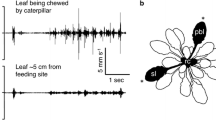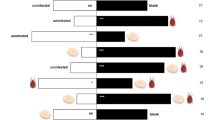Abstract
The ventral eversible gland (VEG) in Lepidopteran larvae was first reported by De Geer in 1745. Secretions from VEG have been associated with defense against predators and the production of anti-aggregation pheromones; however, the role of the VEG in arthropod–plant interactions is still unclear. Here, we show that the ablation of Spodoptera littoralis larvae VEG affects early Arabidopsis thaliana responses to herbivory and insect’s oral secretions (OS). We measured the plasma transmembrane potential (Vm) variation in Arabidopsis mesophyll palisade cells upon feeding by untreated (N) and VEG-ablated (VEGA) S. littoralis larvae. OS from both N and VEGA were collected from larvae feeding on either artificial diet (ADOS) or Arabidopsis green leaves (GLOS) and tested for their ability to affect Vm on intact Arabidopsis leaves. Calcium and hydrogen peroxide (H2O2) signaling were also evaluated by confocal laser scanning microscopy by using the fluorescent probes calcium orange and Amplex red, respectively, upon herbivory by N and VEGA, and after application of either ADOS or GLOS from both N and VEGA to Arabidopsis leaves. Ablation of VEG prompted a significant reduction of the Vm depolarization and significantly reduced both cytosolic calcium concentration ([Ca2+]cyt) and H2O2 burst. OS extracted from VEGA larvae showed the same pattern, suggesting that a functional VEG is required for the synthesis of VEG secretions able to induce early responses in the fed plant tissues. These results suggest that VEG might contain elicitors able to trigger early responses (Vm depolarization, [Ca2+]cyt influx and H2O2 burst) of Arabidopsis to S. littoralis herbivory.




Similar content being viewed by others
References
Afshar K, Dufresne PJ, Pan L, Merkx-Jacques M, Bede JC (2010) Diet-specific salivary gene expression and glucose oxidase activity in Spodoptera exigua (Lepidoptera Noctuidae) larvae. J Insect Physiol 56:1798–1806
Arimura G, Maffei ME (2010) Calcium and secondary CPK signaling in plants in response to herbivore attack. Biochem Biophys Res Commun 400:455–460
Arimura GI, Ozawa R, Maffei ME (2011) Recent advances in plant early signaling in response to herbivory. Int J Mol Sci 12:3723–3739
Babic B, Poisson A, Darwish S, Lacasse J, Merkx-Jacques M, Despland E, Bede JC (2008) Influence of dietary nutritional composition on caterpillar salivary enzyme activity. J Insect Physiol 54:286–296
Baldwin IT (2010) Plant volatiles. Curr Biol 20:R392–R397
Bede JC, Musser RO, Felton GW, Korth KL (2006) Caterpillar herbivory and salivary enzymes decrease transcript levels of Medicago truncatula genes encoding early enzymes in terpenoid biosynthesis. Plant Mol Biol 60:519–531
Bonaventure G, VanDoorn A, Baldwin IT (2011) Herbivore-associated elicitors: FAC signaling and metabolism. Trends Plant Sci 16:294–299
Boyes DC, Zayed AM, Ascenzi R, McCaskill AJ, Hoffman NE, Davis KR, Gorlach J (2001) Growth stage-based phenotypic analysis of Arabidopsis: a model for high throughput functional genomics in plants. Plant Cell 13:1499–1510
Bricchi I, Leitner M, Foti M, Mithofer A, Boland W, Maffei ME (2010) Robotic mechanical wounding (MecWorm) versus herbivore-induced responses: early signaling and volatile emission in Lima bean (Phaseolus lunatus L.). Planta 232:719–729
Corpas FJ, Barroso JB, del Rio LA (2001) Peroxisomes as a source of reactive oxygen species and nitric oxide signal molecules in plant cells. Trends Plant Sci 6:145–150
del Rio LA (2011) Peroxisomes as a cellular source of reactive nitrogen species signal molecules. Arch Biochem Biophys 506:1–11
del Rio LA, Sandalio LM, Corpas FJ, Palma JM, Barroso JB (2006) Reactive oxygen species and reactive nitrogen species in peroxisomes. production, scavenging, and role in cell signaling. Plant Physiol 141:330–335
Gleason C, Huang S, Thatcher LF, Foley RC, Anderson CR, Carroll AJ, Millar A, Singh KB (2011) Mitochondrial complex II has a key role in mitochondrial-derived reactive oxygen species influence on plant stress gene regulation and defense. Proc Natl Acad Sci USA 108:10768–10773
Kanchiswamy CN, Muroi A, Maffei ME, Yoshioka H, Sawasaki T, Arimura G (2010) Ca2+-dependent protein kinases and their substrate HsfB2a are differently involved in the heat response signaling pathway in Arabidopsis. Plant Biotechnol 27:469–473
Komatsu K, Takahashi M, Nakazawa Y (2010) Genetic study on resistance to the common cutworm and other leaf-eating insects in soybean. Jarq Japan Agric Res Quart 44:117–125
Latter OH (1897) The prothoracic gland of Dicranura vinula and other notes. Trans R Entomol Soc Lond 45:113–127
Lecourieux D, Mazars C, Pauly N, Ranjeva R, Pugin A (2002) Analysis and effects of cytosolic free calcium increases in response to elicitors in Nicotiana plumbaginifolia cells. Plant Cell 14:2627–2641
Liu XN, Liang P, Gao XW, Shi XY (2006) Induction of the cytochrome P450 activity by plant allelochemicals in the cotton bollworm, Helicoverpa armigera (Hubner). Pest Biochem Physiol 84:127–134
Maffei M, Bossi S, Spiteller D, Mithöfer A, Boland W (2004) Effects of feeding Spodoptera littoralis on lima bean leaves. I. Membrane potentials, intracellular calcium variations, oral secretions, and regurgitate components. Plant Physiol 134:1752–1762
Maffei ME, Mithöfer A, Arimura GI, Uchtenhagen H, Bossi S, Bertea CM, Cucuzza LS, Novero M, Volpe V, Quadro S, Boland W (2006) Effects of feeding Spodoptera littoralis on lima bean leaves. III. Membrane depolarization and involvement of hydrogen peroxide. Plant Physiol 140:1022–1035
Maffei ME, Mithöfer A, Boland W (2007a) Before gene expression: early events in plant-insect interaction. Trends Plant Sci 12:310–316
Maffei ME, Mithöfer A, Boland W (2007b) Insects feeding on plants: rapid signals and responses preceding the induction of phytochemical release. Phytochemistry 68:2946–2959
Marti OG, Hamm JJ (1987) Discharge of hemolymph from the ventral eversible gland of ascovirus-infected fall armyworm larvae, Spodoptera frugiperda (Lepidoptera, Noctuidae). J Invert Pathol 49:127–129
Marti OG, Rogers CE (1988) Anatomy of the ventral eversible gland of fall armyworm, Spodoptera frugiperda (Lepidoptera, Noctuidae), larvae. Ann Entomol Soc Am 81:308–317
Merkx-Jacques M, Bede JC (2004) Caterpillar salivary enzymes: “eliciting” a response. Phytoprotection 85:33–37
Mithöfer A, Ebel J, Bhagwat AA, Boller T, Neuhaus-Url G (1999) Transgenic aequorin monitors cytosolic calcium transients in soybean cells challenged with beta-glucan or chitin elicitors. Planta 207:566–574
Mithöfer A, Boland W, Maffei ME (2009a) Chemical ecology of plant–insect interactions. In: Parker J (ed) Molecular aspects of plant disease resistance. Wiley-Blackwell, Chirchester, pp 261–291
Mithöfer A, Mazars C, Maffei ME (2009b) Probing spatio-temporal intracellular calcium variations in plants. Methods Mol Biol 479:79–92
Mori N, Yoshinaga N (2011) Function and evolutionary diversity of fatty acid amino acid conjugates in insects. J Plant Interact 6:103–107
Morker KH, Roberts MR (2011) Light as both an input and an output of wound-induced reactive oxygen formation in Arabidopsis leaves. Plant Signal Behav 6:1087–1089
Musser RO, Farmer E, Peiffer M, Williams SA, Felton GW (2006) Ablation of caterpillar labial salivary glands: technique for determining the role of saliva in insect-plant interactions. J Chem Ecol 32:981–992
Nyathi Y, Baker A (2006) Plant peroxisomes as a source of signalling molecules. BiochimBiophys Acta Mol Cell Res 1763:1478–1495
Sagi M, Fluhr R (2006) Production of reactive oxygen species by plant NADPH oxidases. Plant Physiol 141:336–340
Salloum A, Colson V, Marion-Poll F (2011) Appetitive and aversive learning in Spodoptera littoralis larvae. Chem Sens 36:725–731
Severson RF, Rogers CE, Marti OG, Gueldner RC, Arrendale RF (1991) Ventral eversible gland volatiles from larvae of the fall armyworm, Spodoptera frugiperda (Smith,J.E.) (Lepidoptera, Noctuidae). Agric Biol Chem 55:2527–2530
Speidel W, Fanger H, Naumann CM (1996) The phylogeny of the Noctuidae (Lepidoptera). Syst Entomol 21:219–251
Swanson SJ, Choi WG, Chanoca A, Gilroy S (2011) In vivo imaging of Ca2+, pH, and reactive oxygen species using fluorescent probes in plants. Annu Rev Plant Biol 62:273–297
Thivierge K, Prado A, Driscoll BT, Bonneil E, Thibault P, Bede JC (2010) Caterpillar- and salivary-specific modification of plant proteins. J Proteome Res 9:5887–5895
Weatherston I, Macdonald JA, Miller D, Riere G, Percycunningham JE, Benn MH (1986) Ultrastructure of exocrine prothoracic gland of Datana ministra (Drury) (Lepidoptera, Notodontidae) and the nature of its secretion. J Chem Ecol 12:2039–2050
Wu JQ, Baldwin IT (2010) New insights into plant responses to the attack from insect herbivores. Annu Rev Genet 44:1–24
Acknowledgments
The authors thank R. Reist from Syngenta Crop. Protection Münchwilen AG, Switzerland, for kindly providing eggs of S. littoralis. This work was partly supported by the Doctorate School of Pharmaceutical and Molecular Sciences (University of Turin). The authors are grateful to C. Brillada for technical assistance during OS extraction.
Author information
Authors and Affiliations
Corresponding author
Additional information
Handling Editor: Chen-Zhu Wang.
Electronic supplementary material
Below is the link to the electronic supplementary material.
Supplementary material 1 (MPG 2322 kb)
Supplementary material 2 (MPG 3522 kb)
Rights and permissions
About this article
Cite this article
Zebelo, S.A., Maffei, M.E. The ventral eversible gland (VEG) of Spodoptera littoralis triggers early responses to herbivory in Arabidopsis thaliana . Arthropod-Plant Interactions 6, 543–551 (2012). https://doi.org/10.1007/s11829-012-9200-9
Received:
Accepted:
Published:
Issue Date:
DOI: https://doi.org/10.1007/s11829-012-9200-9




